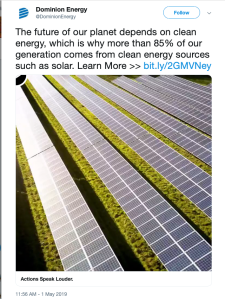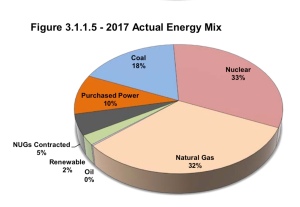
Photo credit: Neep at the English Language Wikipedia, via Wikimedia Commons.
Most people who install renewable energy systems on their property do so at least partly to save money on their electricity bill. Yet more than 30,000 Virginians have shown they will pay more on their electricity bills for a product labeled as green energy, with no hope of ever recovering their investment. These are the participants in Dominion Virginia Power’s voluntary Green Power Program. The size and growth rate of this program don’t mean it’s a good option (it’s not), but it does demonstrate the huge consumer appetite for wind and solar in a state that offers little of it.
In the last couple of years, other companies have created their own renewable energy products to compete with Dominion’s and other utility programs. They typically offer 100% wind power (Arcadia Power and Groundswell) or a mix of wind and other renewables (e.g., 3Degrees, which is Dominion’s broker, but which also sells RECs directly). The companies often partner with environmental groups that help recruit residential customers in return for a donation. Recently the Sierra Club announced it had entered into a partnership with Arcadia.
I’ve been skeptical of the value of voluntary REC products offered to Virginia consumers. I’d rather see people install their own solar; or if they can’t do that, to contribute directly to a solar installation on a local church, school or low-income housing unit, or use their influence as alumni donors to goad their alma maters into installing renewable energy on campus. But with the numbers of green power participants growing, and my own favorite environmental group now promoting one of them, it seems like a good time to revisit the question: is it worth spending your money on a green power program?
Arcadia and other programs share certain elements with Dominion’s Green Power Program: you continue to buy the same conventional “brown” power you always have, but in addition you are billed a premium that goes to buy renewable energy certificates (RECs), as well as pay the broker. The RECs represent renewable energy generated—and used—somewhere else, often not in the same state or even the same region.
In other states, green power programs often sell RECs “bundled” with the underlying power. But in Virginia, only your own utility will sell you power, and for reasons I can’t fathom, our utilities don’t offer renewable energy. So the best you can do is buy RECs.
Buying RECs is supposed to give you a claim to the renewable energy they represent. Obviously, that’s a stretch if you live in Virginia and the RECs you buy come from a wind farm in Indiana, or if you’re buying RECs from solar panels installed on someone else’s roof. Participating in a green power program can require a certain suspension of disbelief.
At best, buying RECs through a green power program supports a market for renewable energy. Ideally, the money would incentivize new projects, but it doesn’t always work that way. A developer can’t count income from RECs when it looks for project financing unless it has a long-term contract with a buyer for the RECs; so for new projects to go forward without such long-term contracts, they have to make financial sense without the RECs. In that case, the REC sales are simply a nice addition to the bottom line.
Arcadia says it hopes to grow to a point where it can contract with a wind developer for the RECs from a new wind farm, but meanwhile it buys RECs from existing projects.
This is not a problem in states that have good Renewable Portfolio Standards (RPS). Those laws create REC markets that support new renewable energy development within their borders (and occasionally from other states). RECs in RPS states command higher prices in long-term contracts.*
As it happens, though, the best wind is often in conservative western or Midwestern states that lack RPS laws or have weak goals. So these green power programs can be seen as a way for good-hearted liberals to send money to red states. Admittedly, that may not be quite what they intended.
Even if they know all this, some people sign up for these programs anyway—either to send a message to their utility that they want cleaner electricity and are willing to pay for it, or for the psychological value of offsetting their fossil fuel consumption. For these people, there are reasons to prefer the Arcadia or Groundswell program to Dominion’s:
- Arcadia uses 100% wind power. Dominion uses a mix of resources, including 29% biomass. The web site is not clear about what this means; it references landfill gas and agricultural biogas, neither of which are usually considered biomass. Environmentalists have concerns about using biomass (specially grown crops or, more commonly, wood from trees) for a number of reasons that include pollution and sustainability issues.
- Dominion’s program costs subscribers 1.3 cents/kWh. At least in past years, approximately half of the money collected was spent on overhead and promotion. Arcadia’s program costs subscribers 1.2 cents/kWh. I have been unable to determine how much of that goes for program costs.
- When you sign up for Arcadia, the company takes over your billing from Dominion. You receive bills directly from Arcadia. That sends a signal to Dominion that its customers want renewable energy, but don’t want to participate in Dominion’s greenwashing.
Of course, these programs only exist because our utilities have been so slow to incorporate wind and solar into Virginia’s energy mix. The solution is to let consumers buy wind and solar directly from producers anywhere in the state—a choice that is forbidden to them now—and ultimately, to create a 21st century energy economy based on sustainable and renewable energy.
The climate crisis makes that an urgent priority for everyone. We won’t achieve it if we merely rely only on volunteers.
______________________________
*An interesting question is what will happen to the voluntary REC market when the Clean Power Plan kicks in. Electricity from new renewable energy projects will acquire a higher value when coal-heavy states have to start buying Emission Rate Credits (ERCs). The EPA stresses that ERCs are not the same as RECs, but most of us would say that if one buyer holds the ERC and another the REC from the same unit of energy, something has gone very wrong.


